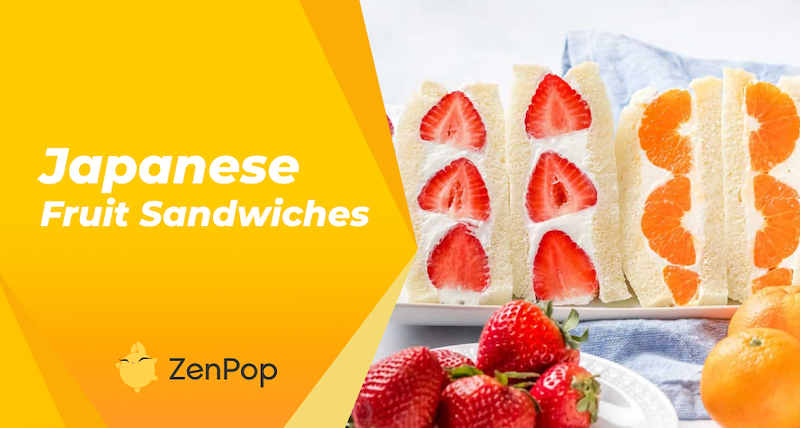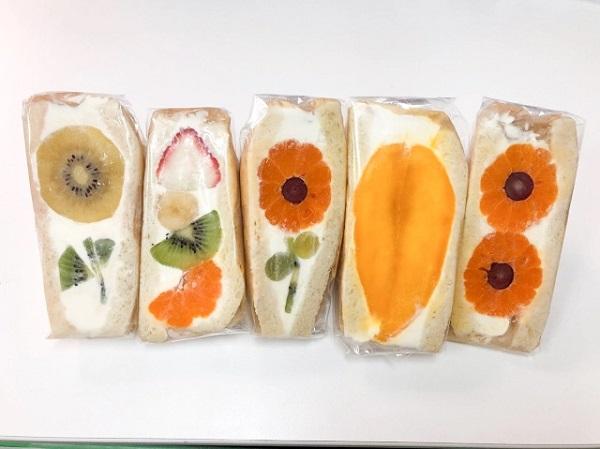
</title><meta name="robots" content="noindex">What is a Japanese Fruit Sandwich?
Japanese fruit sandwich, also commonly known as fruit sando (フルーツサンド), is a tasty snack or dessert made with fresh juicy seasonal fruits, Japanese milk bread, also known as "Shokupan," and whipped cream. A bite into this very delicious snack is a burst of juicy goodness that leaves one in a refreshing state of mind. Japanese fruit sando is perfect for satisfying your sweet cravings and is easy to whip up for consumption at home.
Want to know more about this fruit sando and how to make a perfect one for you? Stay tuned!
THE HISTORY OF JAPANESE FRUIT SANDWICH

The Japanese fruit sandwich dates back to when fruits were a luxury in Japan. However, there are several claims over how the fruit sandwich got invented, of which one is attributed to a fruit stand called Yaoiso, located in Kyoto in the year 1869. The claim is that this stand had been selling fruit sandwiches before their café opened in 1972.
Another claim is from Sembikiya. Its first fruit parlor was opened in the year 1868 in Tokyo and they claim to have invented the fruit sandwich. There is no historical record of when the fruit sando was added to the menu, but it has remained a popular item in their cafes and stores all around Tokyo.
WHAT MAKES UP A JAPANESE FRUIT SANDWICH?

For a very delicious snack like the fruit sando, not much is required. However, these are the essential ingredients you will need in making your fruit sandwich:
- Bread: not just any bread. To get a perfect fruit sando, the best bread to use is shokupan, also called "Japanese milk bread." This bread’s fluffy and soft texture makes it ideal for the sando. Also, this bread, though sliced, is very thick, making it perfect for holding up the moisture from the juicy fruits that will be used. Another substitute for shokupan in making the fruit sando is a sliced-thick and fluffy white sandwich bread.
- Fruits: these are the most important ingredients for making the fruit sando. There is no fruit sando without the fruit in it. The most popular fruit is the strawberry, which is usually referred to as "Ichigo sando." Other fruits are mango, grapes, pineapple, blueberries, oranges, kiwis, and papayas that can match your taste. For a very colorful fruit sando, assortments of fruits are used. The fruits make the sando attractive and juicy.
- Whipped cream: you don't want your fruits falling apart from the sandwich. A perfectly made whipped cream helps to hold up the bread and the fruits. Also, it adds beauty and, of course, deliciousness! A look and a bite of a fruit sando, and you will not doubt the need for whipped cream in a fruit sando. Thickened and heavy whipping cream is required for a good fruit sando. Chill the heavy whipping cream before use; this will help thicken the cream. Add your chilled whipping cream and sugar into a bowl to make your own whipped cream. Whisk or use a mixer till it is well whipped.
Before we tell you how to make one, you might be interested in learning more about Japanese Fruits! We've got plenty of articles covering
- Why Japanese Watermelons are squared
- Why Japanese peaches can be so expensive
- What are Amaou strawberries
HOW TO MAKE JAPANESE FRUIT SANDWICH

A fruit sando is very easy to make; anybody can whip up a quick one. As long as you have the required ingredients, you are good to go. So, in precise steps, let's go over making a Japanese fruit sandwich.
- The first step is to get your complete ingredients ready. You can't skip any of the ingredients explained above; they all work together to create a very good fruit sando.
- Get your whipped cream ready. As explained earlier, refrigerated heavy whipped cream is best. When it is ready, you should keep it chilled before use because it will thicken and harden to hold up the sandwich.
- Next, get your fresh and juicy fruit ready. Use fresh seasonal fruits to get the best taste. Arranging the fruit sandwich is the most fun and exciting part of making it; the assortment of fruits, the types and colors, and the shapes. There is no limit to how you can get creative with the type of fruits you use. Just ensure they are thoroughly rinsed and peeled if the fruit requires it. Also, to get a cuter version of a fruit sando, use fruits of the same size. For example, strawberry and kiwi, the same slice of papaya, and mango. It is important to note that after rinsing the fruits, rub them dry with a clean cloth. We are avoiding moisture to keep the bread from becoming soggy.
- Whipped cream melts at room temperature, which will make the bread soggy. To avoid this, add a layer of jam on the side of the bread that gets smeared with the whipped cream. The jam helps keep the bread from absorbing the moisture from the whipped cream.
- After this, smear the whipped cream over the jam-layered bread. Smear it neatly and thickly over the bread with a spatula.
- Then you arrange the fruits over it so that it reveals the cross-section of how you want them to appear when the fruit sando is done. The design of the fruit sando after it's all done depends on you. How exciting!
- After that, another layer of whipped cream will be added to the fruits. Do not leave any space between the fruits. Be generous with the amount of whipped cream used. Cover it with the second sandwich bread and wrap it tightly with plastic wrap.
- Refrigerate the fruit sando for at least 20 minutes, or maybe leave it overnight to be eaten the next day.
When you are set to enjoy your juicy goodness, unwrap the fruit sando. Slice in the shape you would want the fruit pattern to appear. Voila! Enjoy your own freshly made healthy and very delicious fruit sando.
The Japanese fruit sandwich is the perfect blend of healthy and deliciousness. You can get yours freshly ordered at stores that sell them or make your own in simple and easy steps. If you want to indulge in other snacks from Japan, check out our Zenpop snack pack for your monthly package.
This article was originally written by our freelance writer Umm-Kulthum Abdulkareem, and edited by us.



